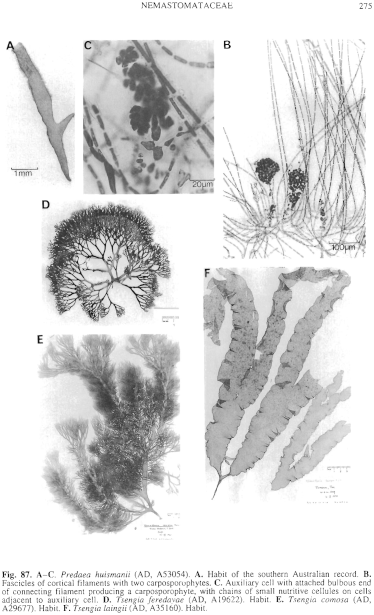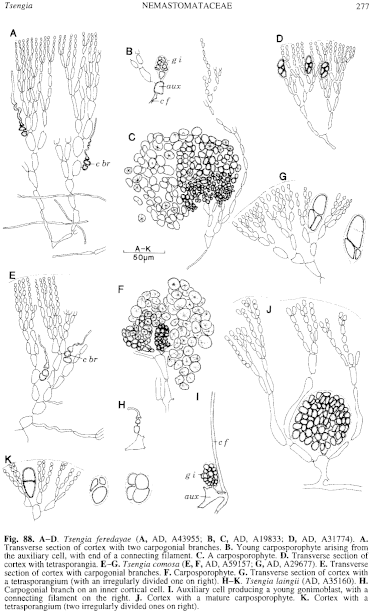|
|
|
|
|
|||||||||||
|
Electronic Flora of South Australia Species Fact Sheet
Phylum Rhodophyta – Class Florideophyceae – Order Gigartinales – Family Nemastomataceae
Synonym
Nemastoma laingii Kylin 1932: 8, fig. 1C, pl. 2 fig. 4. Chapman 1979: 284, fig. 77, pls 97,98,101.
Thallus (Fig. 87F) medium red-brown, slightly mottled, 15–50 cm high, flat, furcately branched 2–3 times, broadening gradually or rapidly from a slender stipe 2–4 cm long to the mid thallus 2–7 (–15) cm broad and 400–800 (–1000) 1.1.M thick, decreasing above to 1–3 cm broad, margin strongly ruffled with occasional small to moderate marginal proliferations. Holdfast discoid, 1–2 mm across; epilithic. Structure of a cortex 80–120 IAITI thick, of discrete branch systems, with an inner cortex of 2–3 subdichotomies of ovoid cells 8–14 µm in diameter, and outer cortex of mostly unbranched rows of 4–5 cells, each 6–8 µm in diameter and L/D 1.5–2; gland cells absent; medulla broad, of entangled filaments of long cells 4–6 µm in diameter. Rhodoplasts few per cell, elongate.
Reproduction: Sexual thalli monoecious. Carpogonial branches (Fig. 88H) 3-celled, borne on innermost cortical cells, trichogyne relatively straight; inner cortical cells acting as auxiliary cells, connecting filaments stout, branched, continuing beyond an auxiliary cell (Fig. 88 1). Carposporophyte (Fig. 88J) developing from the auxiliary cell, elongate to conical, 80–120 µm across, with all cells becoming ovoid to angular carposporangia 10–15 µm across, lying within the cortex without a pore between the filaments. Spermatangial heads(?) dense, subspherical, situated on cortical filaments, consisting of a dense mass of spermatangia.
Tetrasporangia (Fig. 88K) borne on inner cortical cells, ovoid, 40–50 µm long and 20–30 µm in diameter, cruciately divided.
Type from Brighton (Christchurch), New Zealand (Laing, 23.x.1930); holotype in LD.
Distribution: South and Stewart Is, N.Z.
Port MacDonnell, S. Aust., to Warrnambool, Vic., and SE Tasmania.
Taxonomic notes: The Tasmanian specimens agree well with those from New Zealand, being distinctive in habit, in the enlargement of inner and mid cortical cells around the carposporophyte, and in the cruciate tetrasporangia. Some specimens (e.g. AD, A61778) become broadly foliose (10–15 cm broad) as collected in the drift.
References:
CHAPMAN, V.J. (1979). The marine algae of New Zealand. Part DI Rhodophyceae. Issue 4: Gigartinales. (Cramer: Germany.)
KYLIN, H. (1932). Die Florideenordnung Gigartinales. Lunds Univ. Årsskr. N.F. Avd. 2, 28 (8), 1–88, Plates 1–28.
The Marine Benthic Flora of Southern Australia Part IIIA complete list of references.
Publication:
Womersley, H.B.S. (14 January, 1994)
The Marine Benthic Flora of Southern Australia
Rhodophyta. Part IIIA, Bangiophyceae and Florideophyceae (to Gigartinales)
Reproduced with permission from The Marine Benthic Flora of Southern Australia Part IIIA 1994, by H.B.S. Womersley. Australian Biological Resources Study, Canberra. Copyright Commonwealth of Australia.
Illustrations in Womersley Part IIIA, 1994: FIGS 87F, 88 H–K.

Figure 87 enlarge
Fig. 87. A–C. Predaea huismanii (AD, A53054). A. Habit of the southern Australian record. B. Fascicles of cortical filaments with two carposporophytes. C. Auxiliary cell with attached bulbous end of connecting filament producing a carposporophyte, with chains of small nutritive cellules on cells adjacent to auxiliary cell. D. Tsengia feredayae (AD, A19622). Habit. E. Tsengia comosa (AD, A29677). Habit. F. Tsengia laingii (AD, A35160). Habit.

Figure 88 enlarge
Fig. 88. A–D. Tsengia feredayae (A, AD, A43955; B, C, AD, A19833; D, AD, A31774). A. Transverse section of cortex with two carpogonial branches. B. Young carposporophyte arising from the auxiliary cell, with end of a connecting filament. C. A carposporophyte. D. Transverse section of cortex with tetrasporangia. E–G. Tsengia comosa (E, F, AD, A59157; G, AD, A29677). E. Transverse section of cortex with carpogonial branches. F. Carposporophyte. G. Transverse section of cortex with a tetrasporangium (with an irregularly divided one on right). H–K. Tsengia laingii (AD, A35160). H. Carpogonial branch on an inner cortical cell. I. Auxiliary cell producing a young gonimoblast, with a connecting filament on the right. J. Cortex with a mature carposporophyte. K. Cortex with a tetrasporangium (two irregularly divided ones on right).

|
Email Contact: State Herbarium of South Australia |

|